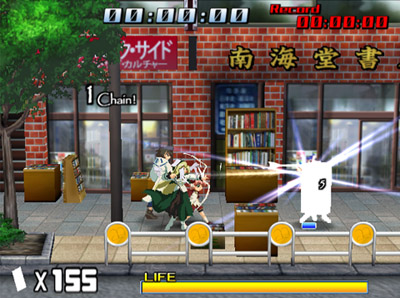Burn-Up Scramble, disc 2
Not as amusing as the first one, but lots more Maya, which is good. It feels like they were trying too hard to make it silly, with three of the four episodes stepping outside the basic premise. The result is that we learn that Lilica is a cheap date, Maya enjoys spinning yarns, and Rio should never sleep with the television on. These episodes aren’t bad, just a bit flat, and are redeemed by the costumes (Naked Apron Lilica, Attack of the Fifty-Foot Rio, and pretty much everything they dress Maya in).
In other news, the people responsible for the credits have started to figure out the miracle that is anti-aliasing. They’re not using it consistently yet, but one can hope they’ll continue to improve. Of course, they’ve only got one more disc to practice with…
And the award for worst anime goes to...
Eiken, for its horrible voice acting and attack-of-the-killer-blob “breasts”. I have finally found fan-service that is not only unappealing, but actively repulsive.
I wasn’t expecting it to be good. I wasn’t even expecting it to be okay, given the screenshots and DVD cover art, but I was curious to see where the current trend toward breast-inflation in anime is going, and I figured I could put up with the ridiculously oversized boobs.
Unfortunately, not only is the voice acting awful, the… things attached to the girls’ chests don’t even qualify as breasts, of any size or provenance. Thank goodness there was no actual nudity in the few minutes I was able to force myself to watch. Amazing Nurse Nanako and Ikkitousen put together couldn’t suck as hard as this disc, because no matter how terrible they were, they at least had something going for them besides the character designs. This show has nothing; if a masked psycho had started murdering the cast on-screen, I’d have cheered her on.
Burn-Up Excess, disc 1
After my positive experience with Burn-Up Scramble, discs 1 and 2, I decided to check out the previous instance of the franchise. Multiple review sites suggested that Excess was the best of the bunch, but I like Scramble better.
Why? Everything about Excess is self-consciously wacky. The character designs, the bouncing boobs, the nosebleeds, the dialog, the action, etc, etc. There are some nice moments, and it’s still a well-polished, amusing product, but I really don’t care about the characters, who are pretty much cardboard cutouts with simple labels attached. The voice actors do a decent job with the material, but it’s all surface. In Scramble, on the other hand, Rio and Maya are interesting people, and their relationship has some depth to it.
Perhaps the best way to summarize the difference between the two is to compare the “Maya goes home to see her family” episodes. In Excess, she’s reunited with her crazy father and his goofy minions, and ends up on top of an exploding dirigible in a Playboy bunny suit, with a belt-fed machine-gun in each hand, madly spraying ammo; in Scramble, she’s sitting in a bar with Rio and Lilica, telling them about her childhood, her reunion with her foster father, and a terrific Noir-ish battle scene, with (occasionally silly) visuals as imagined by the gullible Lilica.
Both incarnations of Maya are gun-crazy, but in different ways. In Excess, it’s clearly sexual: she visibly suffers when she can’t bang, and goes wild when she finally gets release. In Scramble, Maya is the (relatively) sane, mature member of the team, who derives as much pleasure from collecting guns as from shooting them; she’s obsessive about it, but otherwise stable.
If you haven’t caught on yet, I really like Maya in her Scramble incarnation.
"Here I come, on the run, with a burger on a bun..."
Alternative caption: “You know what the difference is between you and me? I make this look good.”
I always knew they were real
Everywhere I’ve worked, people believe in them. They’re the ones who clear jams, change toner cartridges, reload the paper trays, and clean up the messy pile of abandoned printouts, and finally they’ve been captured on film. I give you…
How I'm trying to learn Japanese
Between my long-standing interest in anime and my on-and-off interest in Japan, I eventually became motivated to acquire at least a working knowledge of the language. Unfortunately, I know from long experience that I don’t do well in a traditional classroom setting (last I checked, the buzzwords were “underachieving gifted”), and in any case my rather irregular work schedule would make it difficult to even try.
As a result, I started looking at the available software packages, to see if any of them had any real merit. After a few weeks, I settled on Rosetta Stone, occasionally available in stores, but mostly acquired either by mail-order, online purchase, or at one of their mall kiosks (new one just opened up at Valley Fair in San Jose, by the way). They have standalone, online, and classroom packages, a pretty good reputation, and a significantly higher price than most of the alternatives.
A lot of the other software uses romanized text instead of the real Japanese writing systems, which makes things easier for absolute beginners, but effectively cripples them in the long run. RS allows you to work with romanized text, but offers both kana and kanji as options, so that you can acquire reading skills that will actually be useful.
It does not, however, teach them. For learning the hiragana and katakana syllabaries, I used the commonly recommended Easy Kana Workbook, along with LanguageBug’s free Java flashcards for cellphones. I went through approximately half of the RS Level 1 course this way, with all dialog spelled out phonetically.
Meanwhile, I started working on kanji, using the appropriately-named A Guide to Writing Kanji and Kana. It’s slow going, due in large part to the hand cramping I developed from writing each character 100 times, but I’m making real progress, to the point where I can slowly, painfully read magazine and manga text with the help of The Kodansha Kanji Learner’s Dictionary (not to be confused with The Learner’s Kanji Dictionary…).
A while back, I finished my first complete pass through the RS Level 1 software, and it’s done a lot for my comprehension and reading skills. I’ve gotten less out of the voice-training feature, largely because the feedback is unclear; it’s extremely finicky about intonation and cadence, but lacks the ability to highlight your mistakes in a way that you can correct. If you don’t have a good ear for language, you could sit there for hours without making it through the first lesson. Even if you do (and, thanks to a youth spent in my father’s office in the Language Department at UD, I generally do), it may still take a while for you to figure out what kind of mistake you’re making.
For instance, I had an early tendency to fail on any phrase that included the word otokonoko, and only that one word. Why? My cadence was off. I was making some syllables shorter than others, and the waveform display didn’t show it. It finally dawned on me that I got better results with my eyes closed. Shutting out the picture and the waveform display allowed me to focus on more precisely mimicking the sample phrase.
Was it worth the cash? Yes. I get a lot more out of spoken Japanese in anime and when I shop at Kinokuniya Books and Mitsuwa Market. Spending an hour a day listening to native speakers pronounce realistic phrases that I know the meaning of has done a lot for my understanding, and seeing them written out in kanji and kana at the same time has given me some basic reading skills.
What can’t I do right now? Carry on a conversation. Write an original paragraph without a reference book handy. Software won’t supply those skills, but it can give me a decent framework to build them on top of. The Level 2 software (which, sadly, has a completely different set of native speakers, one of whom speaks in an extremely annoying staccato) will contribute further to that framework.
Is Rosetta Stone the best language software out there? Is their learning model pedagogically sound? I can’t give definitive answers to these questions. I do know that, within the limits of the supplied vocabulary, their model produces comprehension without translation. This is dramatically better than the approach used in my high-school German and French classes twenty-plus years ago, which left me with some vague recognition skills and the ability to sing Du kannst nicht immer siebzehn sein.
They had me at 'Ohayou'
Okay, the gameplay looks pretty standard. The graphics are colorful and well-rendered, though, and one of the screenshots suggests that you’re not limited to (literally) pedestrian locations, but that’s not what won me over about this video game based on the R.O.D The TV anime series.

It was the title, ElePaperAction.
Ai Yori Aoshi: honorifics and sex appeal
I finally got around to watching the last volume of the first Ai Yori Aoshi series, which is a mostly-successful romantic comedy in the harem genre. The art and animation are quite good, the music works, the voice acting is excellent, the antics are generally amusing, and while the characters are built on common genre stereotypes, most of them manage to grow into interesting people over time. The reason it’s only mostly-successful is that the core romance moves forward at a glacial pace, but this is largely an artifact of their attempt to remain mostly consistent with the original manga.
The only real twist in this “nice guy ends up living in a house full of beautiful women who want him” story is that the childhood-friend/first-love character bags him before any of the others ever have a chance, but must keep this a secret to avoid a family scandal. This leaves the rest with the impression that his heart is up for grabs, and, as they say, “wackiness ensues”.
The female cast provides plenty of variety for a “who would you pick” poll, but the series is so popular (as both manga and anime) that I feel no need to create another one. Instead, I’ll give my own impressions of the cast, and focus on something that I found flawed in the setup of the story, namely the way the “big secret” is constantly compromised by the way certain characters address each other.
(spoilers of various degrees follow; now updated with links to larger screenshots)
Believe it or not...
I picked up the DVD box of the first season of The Greatest American Hero, and watched the two-hour pilot episode Saturday night with some friends. It held up surprisingly well. Dated as it is in many ways, the acting was at least as good as in most TV pilots, and there’s some great humor, the product of good writers working with actors who “got it”.
I have vague-but-fond memories of the series, and if the rest of the set lives up to the pilot, it should keep me happy until the Hogan’s Heroes box comes out in a few weeks…

